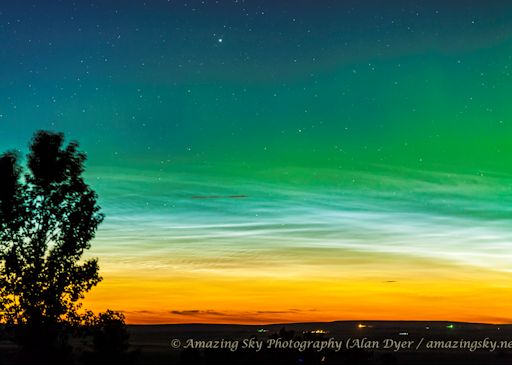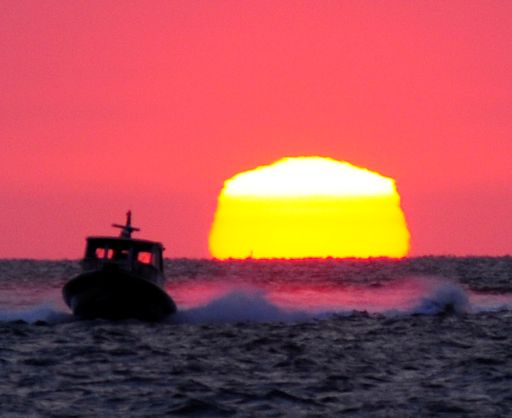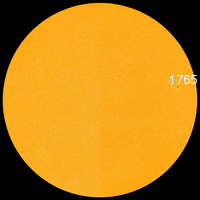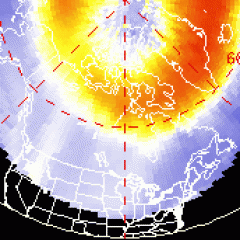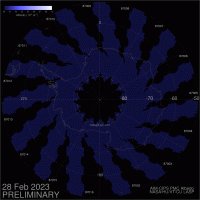NO METEOR OUTBURST? So far we have received no reports of a predicted gamma Delphinid meteor outburst on June 11th. If there was a stream of comet debris near Earth's orbit, either we missed it, or it was populated by meteoroids too small to produce naked-eye meteors. [Meteor radar]
AURORAS + NOCTILUCENT CLOUDS: On Sunday, June 9th, Alan Dyer of Gleichen, Alberta, Canada, went outside to see the colors of the sunset. He got more than he bargained for. Stacked atop the rosy glow of twilight were dual bands of electric-blue noctilucent clouds and green auroras:
"At times the auroral curtains appeared superimposed on the noctilucent clouds," says Dyer. "It isn't often we see the two phenomena together."
That's because they are completely unrelated. Auroras are caused by energetic particles from the sun raining down on Earth's upper atmosphere, causing the air to glow like the picture tube of a color TV. Noctilucent clouds are made of tiny ice crystals wrapped around bits of meteor smoke. Their electric-blue color comes from the scattering of high altitude sunlight. On June 9th the two phenomena overlapped for a rare display.
"Adding to the colours was the deep orange of perpetual twilight rimming the northern horizon," continues Dyer. "It was a beautiful pre-solstice night."
More aurora-noctilucent overlaps might be in the offing. NLC experts say noctilucent clouds have appeared bright and early this year, while 2013 might bring the late surge of a double-peaked Solar Max. High-latitude sky watchers should keep an eye on the sunset. Aurora alerts: text, voice.
Realtime Noctilucent Cloud Photo Gallery
[previous years: 2003, 2004, 2005, 2006, 2007, 2008, 2009, 2011]
WEIRD SUNSET: Astronomers in the Netherlands have discovered a world where the sun is square. It is Earth. On June 6th Jan Koeman was watching the sunset from Lauwersoog, and this is what he saw:
"The sunset was a very weird one," says Koeman. "Inversions in the atmosphere gave it some very odd shapes."
UK atmospheric optics expert Les Cowley was in the Netherlands last week. "Conditions were favorable for this kind of mirage," he says. "To see weird miraged suns look out at sunrise in very cold weather and at sunset when it is hot. We had beautiful hot sunny weather all last week in the Netherlands. The sun heated the land and topmost layers of the sea to generate by early evening strong temperature inversions, layers of unusually warm air beneath cooler air. The setting sun rays slanted through the layers where they were bent to form multiple image slices that combine into outlandish shapes and even stacked pancakes. Sometimes tiny green flashes can be photographed on the topmost pancake."
"I was looking for the green flash," adds Koeman, "but this time no success. More sunsets will follow."

Solar wind
speed: 408.1 km/sec
density: 4.0 protons/cm3
explanation | more data
Updated: Today at 2126 UT
X-ray Solar Flares
6-hr max: B1 1504 UT Jun11
24-hr: B2 0425 UT Jun11
explanation | more data
Updated: Today at: 2100 UT
![]()
Daily Sun: 11 Jun 13
Sunspot AR1765 has a simple magnetic field that does not pose a threat for strong solar flares. Credit: SDO/HMI
![]()
Sunspot number: 21
What is the sunspot number?
Updated 11 Jun 2013
Spotless Days
Current Stretch: 0 days
2013 total: 0 days (0%)
2012 total: 0 days (0%)
2011 total: 2 days (<1%)
2010 total: 51 days (14%)
2009 total: 260 days (71%)
Since 2004: 821 days
Typical Solar Min: 486 days
Update 11 Jun 2013
The Radio Sun
10.7 cm flux: 93 sfu
explanation | more data
Updated 11 Jun 2013
![]()
Current Auroral Oval:
Switch to: Europe, USA, New Zealand, Antarctica
Credit: NOAA/POES
![]()
Planetary K-index
Now: Kp= 2 quiet
24-hr max: Kp= 3 quiet
explanation | more data
Interplanetary Mag. Field
Btotal: 5.0 nT
Bz: 3.8 nT south
explanation | more data
Updated: Today at 1851 UT
![]()
Coronal Holes: 11 Jun 13
There are no large coronal holes on the Earthside of the sun. Credit: SDO/AIA.
![]()
NEW: Spaceweather.com is now posting daily satellite images of noctilucent clouds (NLCs), which hover over Earth's poles at the edge of space. The data come from NASA's AIM spacecraft. The north polar "daisy" pictured below is a composite of near-realtime images from AIM assembled by researchers at the University of Colorado's Laboratory for Atmospheric and Space Physics (LASP). |
![]() Noctilucent Clouds
Noctilucent Clouds
Switch view: Europe, USA, Asia, Polar
Updated at: 06-11-2013 12:55:02

